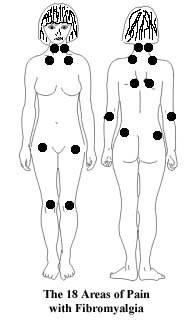Fibromyalgia
Fibromyalgia is a common disease of unknown origin which affects middle aged women in particular. With fibromyalgia you get pain all over the body, with particular joints being especially painful. The pain can be very debilitating and can lead to tiredness and exhaustion.
 It is a disease that lasts a long time and can require quite a bit of treatment and careful management. The pain and stiffness of fibromyalgia presents mainly in the soft -tissues of the body such as muscles, ligaments and tendons and often affects the neck and low back (lumbar) regions. There is not usually swelling with this problem and conventional tests cannot detect this condition.
It is a disease that lasts a long time and can require quite a bit of treatment and careful management. The pain and stiffness of fibromyalgia presents mainly in the soft -tissues of the body such as muscles, ligaments and tendons and often affects the neck and low back (lumbar) regions. There is not usually swelling with this problem and conventional tests cannot detect this condition.
How do you get fibromyalgia?
The cause of this disease is unknown but it is NOT "in your head"! Although depression can be a feature of the disease it is NOT a depressive condition. A number of factors seem to be common in the development of some people's disease, such as thyroid disease, problems sleeping, after a trauma or severe stress or other forms of arthritis (particularly Osteoarthritis - see other page).
People with fibromyalgia have lower pain thresholds and lower levels of a brain chemical that helps with pain, sleep, mood etc.
Symptoms
The symptoms of Fibromyalgia can last for years and can get very uncomfortable, but will vary from day to day!
Pain and joint stiffness is the predominant feature of this disease, particularly around the following joints:-
Base of neck (often leading to headaches), Base of Back, Elbows, Pelvis, Hips, Knees and feet.
Because of lack of sleep, patients feel exhausted.
Depression.
Irritable Bowel Syndrome (IBS)- Fluctuating between diarrhoea and constipation.
"Pins and Needles" sensations or numbness in the arms and legs.
Other common symptoms - Premenstrual syndrome and painful periods; stiffness on getting up; memory impairment; muscle twitching; chest pain; irritable bladder; the feeling of swollen hands and feet; skin sensitivities; dry eyes and mouth, and dizziness.
Diagnosis and treatment
Your Osteopath will take a careful case history and then examine you in great detail, noting your ranges and quality of movement. He will do minor tests for trapped nerves and in rare cases may request an X ray or blood tests to rule out any other problems. When a diagnosis has been reached, your Osteopath will discuss the disease and the treatment options with you.
Although Fibromyalgia can be very painful, the majority of people can be helped, but not cured, by your Osteopath. He should normally be able to reduce your symptoms to a relatively pain-free level and give you advice and exercise to help manage future problems.
This is one of the common conditions that Osteopaths treat and nearly always a patient can be helped by carefully prescribed GENTLE Osteopathic treatment and advice! Scientific studies have recently shown that roughly a quarter of all suffers of Fibromyalgia were in "remission" after 2 years!
We have clinics in:
Crewe, Stockport, Nantwich and Stoke-On-Trent.
Martin Davies is a registered member of the GOSC, BOA, OSCA.
Click Here to See More
Click Here to find out all pricing and information for your consultation.
